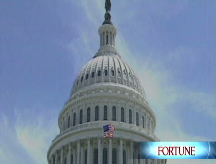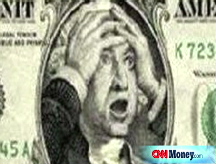Lenders still on edge
Overnight lending rates eased slightly, but 3-month forward looking rates continued to climb. Treasury prices lower.
NEW YORK (CNNMoney.com) -- Lenders remained wary of taking on unnecessary risk until more definitive signs emerge that recent government action is giving the economy a much-needed boost.
The Fed has "done an absolute ton" to juice the economy, said Kim Rupert, fixed income analyst at Action Economics, and yet credit markets are still choked. "Again, it is a matter of confidence and so far no money on earth is able to shake" off the persistent fear gripping lenders.
"It probably will take time and making sure that there are no more shoes out there to drop," for the credit markets to loosen, said Rupert.
However, it wasn't all doom and gloom. Prices of long-term bonds fell, signaling sentiment may be starting to shift in at least one corner.
"Any time we see the Treasury fall in value, it is positive because that is a sign that the fear trade is going back, easing," said William Larkin, portfolio manager at Cabot Money Management.
Market measures: In another sign of just how tight the credit markets still are, the London interbank rate (Libor) remained elevated Thursday.
Libor is a daily average of what 16 different banks charge other banks to lend money in London and is used to calculate adjustable rate mortgages. The higher the rate, the tougher it could be for homeowners pay those mortgages. Libor is also used to calculate other types of loans, including student and auto.
The overnight Libor rate eased to 5.09% after jumping to 5.38% Wednesday, according to Bloomberg.com data, but it still remains near record levels.
The overnight Libor was at 2.15% just four weeks ago. Since then, it has steadily risen and hit a record of 6.88% last Friday, when the $700 billion bailout bill was finally approved and signed into law.
Meanwhile, the 3-month Libor rate continued its ascent, reaching 4.75% Thursday from 4.52% the previous day. The 3-month rate has been on an upward trajectory since its most recent low of 2.82% on Sept. 15 and is at its highest level this year.
Two other gauges further illustrated banks' unwillingness to loosen the purse strings.
The TED spread, for example, reached a record high of 4.14% before retreating to 4.12%. While that was slightly above the 4.02% on Wednesday, the spread was 1.04% just a little more than a month earlier.
The TED spread measures the difference between the 3-month Libor and the 3-month Treasury bill, and is a key indicator of risk. The higher the spread, the bigger the aversion to risk.
Another indicator, the Libor-OIS spread, jumped to a record of 3.47% before ticking slightly lower to 3.46%. That is still higher than the previous day's record of 3.22%. The Libor-OIS spread measures how much cash is available for lending between banks, and is used by banks to determine lending rates. The bigger the spread, the less cash is available for lending.
Treasurys dip: Government bonds, considered a safe haven for investors to park their cash during times of economic uncertainty, were lower Thursday. Rates of return on bonds are not competitive with other investment vehicles, but the principle is safe.
But with the massive selloff in stocks this week, investors may start shifting assets to more risky, but more profitable, equities.
The Dow industrials are down nearly 35% from a year earlier and investors with a longer-term view are starting to view the sharp drop in equities as an opportunity.
"From the 10,000-foot view, there has been some devastation in the market. This is probably not a bad time to put a little bit of money to work," said Larkin.
On Wednesday, the Treasury department announced an additional $30 billion of government bonds for sale. The government auctioned $20 billion of reopened 10-year notes Wednesday and sold another $20 billion Thursday. In addition, Treasury auctioned off a $30 billion cash management bills Thursday. "There is a ton of supply coming down the road in Treasurys," said Rupert.
The jolt of supply helped keep Treasury prices lower, but the volume being auctioned was not out of proportion to what the market could absorb easily, said Larkin. Prices didn't move dramatically following the sales.
Meanwhile, the yield on the 3-month note was 0.58%, up from 0.64% late Wednesday. The short-term note is another safe haven used by investors as a liquid place to keep cash during tumultuous times.
As companies look to cover their financing before the end of the year, firms use the 3-month Treasury note as a source of liquidity, especially given that other sources of lending are still hoarding capital, according to Rupert.
The price of the benchmark 10-year note fell 1-12/32 to 101-18/32 and its yield rose to 3.81% from 3.65% late Wednesday. Bond prices and yields move in opposite directions.
The 30-year long bond reversed direction after an early rally to be 26/32 lower at 106-22/32 and its yield rose to 4.12% from 4.06% late Wednesday. The price on the 2-year note fell 6/32 to 100-22/32 while its yield rose to 1.65%, up from 1.56%.
Looking for confidence: In an effort to backstop consumer sentiment, Treasury Secretary Henry Paulson said Wednesday afternoon that the federal government would use all the tools it has in order to support the financial system. "We will coordinate the use of our existing and new authorities to restore market confidence," he said.
Easy enough to say. But, "confidence is a funny thing - it is difficult to say what will restore it," said Rupert.
G-7 Finance and central bank chiefs were scheduled to meet in Washington Friday. Leaders from United States, Germany, Japan, France, Britain, Italy, Canada, Brazil, Russia, India and China were all expected to attend the meeting.
Leaders and lawmakers were doing everything in their power to juice the frozen lines of credit because when banks don't lend to each other and to consumers, the economy cannot recover. Businesses need to borrow funds to cover short-term expenses, including payrolls, and consumers need access to lending in order to purchase a home, car or finance school tuition.
The latest figures released Thursday morning show total outstanding commercial paper - a short-term asset sold by companies to pay for day-to-day expenses - fell by $56.4 billion, or 3.5%, in the past week, to $1.55 trillion.
The U.S. government said earlier this week that it would step in and purchase commercial papers.
Fed steps in: In an effort to breathe some life into economies around the world, the Federal Reserve, in tandem with five other central banks, on Wednesday lowered its key lending rate to 1.5% from 2%.
However, the global financial crisis has sunk its teeth in to the point that analysts say that the $700 billion bailout plan and the coordinated rate cut were merely steps in the right direction, and analysts say it is going to take much more to really get credit moving.
Wall Street investors flip-flopped on the Fed rate cuts, with stocks seesawing Wednesday, and the Dow industrials ultimately ending down 190 points. Stocks continued to decline Thursday, shedding more than 300 points during the session. ![]()






